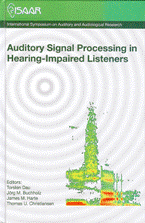Monaural and binaural subjective modulation transfer functions in simple reverberation
Resumé
The temporal intensity envelope of a signal is filtered by the transmission channel through which it passes. The amount of reduction for a given envelope, or modulation, frequency has been called the modulation transfer function (MTF) and can be derived from the impulse response of the transmission channel [Schroeder, M.R. (1981) Modulation transfer-functions: De nition and measurement, Acustica, 49, 179-182]. The envelope of a speech signal is critical for intelligibility, and the speech transmission index (STI) predicts the intelligibility of speech through a given transmission channel based on its MTF [Houtgast, T. and Steeneken, H.J.M. (1973) Modulation transfer-function in room acoustics as a predictor of speech intelligibility, Acustica, 28, 66-73]. In the present study, the results of intensity modulation detection experiments with broadband noise carriers are reported in monaural and binaural conditions, with single reflections at different arrival times in the two ears and with a simulated room impulse response. The monaural data describe a subjective MTF, which is similar to the physical MTF. Binaurally, the thresholds are consistently lower than the monaural thresholds, especially at frequencies where there is a large interaural modulation phase difference. These data show that binaural detection thresholds can be better than either ear alone and better than the predictions from either ear’s physical MTF.
Referencer
Christiansen, T. U., and Greenberg, S. (2005). “Frequency selective filtering of the modulation spectrum and its effect on consonant identification,” 21st Danavox Symposium, Hearing Aid Fitting, edited by A. N. Rasmussen, and T. Poulsen.
Houtgast, T., and Steeneken, H. J. M. (1973). “The modulation transfer function in room acoustics as a predictor of speech intelligibility,” Acustica 28, 66–73.
Houtgast, T., and Steeneken, H. J. M. (1985). “A review of the MTF concept in room acoustics and its use for estimating speech intelligibility in auditoria,” J. Acoust. Soc. Am. 77, 1069–1077.
Miyata, H., Nomura, H., and Houtgast, T. (1991). “Speech-intelligibility and subjective MTF under diotic and dichotic-listening conditions in reverberant sound fields,” Acustica 73, 200–207.
Schroeder, M. R. (1981). “Modulation transfer-functions: Definition and measurement,” Acustica 49, 179–182.
Shannon, R. V., Zeng, F. G., Kamath, V., Wygonski, J., and Ekelid, M. (1995). “Speech recognition with primarily temporal cues,” Science 270, 303–304.
Viemeister, N. F. (1979.) “Temporal modulation transfer functions based upon modulation thresholds,” J. Acoust. Soc. Am. 66, 1364-1380.
Yderligere filer
Publiceret
Citation/Eksport
Nummer
Sektion
Licens
Authors who publish with this journal agree to the following terms:
a. Authors retain copyright* and grant the journal right of first publication with the work simultaneously licensed under a Creative Commons Attribution License that allows others to share the work with an acknowledgement of the work's authorship and initial publication in this journal.
b. Authors are able to enter into separate, additional contractual arrangements for the non-exclusive distribution of the journal's published version of the work (e.g., post it to an institutional repository or publish it in a book), with an acknowledgement of its initial publication in this journal.
c. Authors are permitted and encouraged to post their work online (e.g., in institutional repositories or on their website) prior to and during the submission process, as it can lead to productive exchanges, as well as earlier and greater citation of published work (See The Effect of Open Access).
*From the 2017 issue onward. The Danavox Jubilee Foundation owns the copyright of all articles published in the 1969-2015 issues. However, authors are still allowed to share the work with an acknowledgement of the work's authorship and initial publication in this journal.


